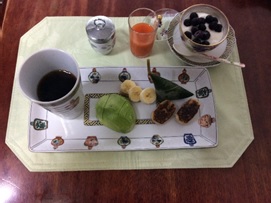Is Emperor Meiji’s breakfast a fu manju and milk coffee? !
 |
One day my breakfast
I heard that Emperor Meiji loved raw fu (Namafu) and red bean paste (An) , and that he had raw fu manju and milk coffee for breakfast. It seems that it was introduced in “The Emperor’s Dining Table”, but I could not confirm it because there was no original.
I also love red bean paste, and since I was a kid I’ve been eating toast with boiled zenzai. In addition, I had always freezed Manju in my house so that I can eat them whenever I didn’t have namagashi.
Fu Manju was first sold by Fu Ka, but it was actually the idea of Emperor Meiji. Did Emperor Meiji, who loved raw bean paste and red bean paste, wanted to wrap a red bean paste in fu. It seems that he usually liked Japanese food.。
The breakfast in the photo is coffee, tomato juice, fu Manju, roasted raw fu banana,Avocato, egg (boiled in egg codler) yogurt.。
In fact, there is a theory that Kimuraya’s Anpan was also the idea of Emperor Meiji. At Ginza Kimuraya, who presented the sake type Anpan to the Emperor Meiji, who went to the Mito clan’s residence (now Mukojima) in 1875, he was said by the emperor and the empress, “Please continue to supply it.” It is said that he received their words. It seems that it was a strategy by reason of respecting Japanese sweets shops in Kyoto and give it to them when they go to other places except Kyoto. The Emperor and Empress liked it so much that Anpan swept spread ou all over Japan in an instant.
Fu Manju is made by wrapping red bean paste with raw fu. There is a baked raw fu in front of the fu Manju in the photo. A fu has a light taste and goes well with Japanese food, but it goes well with coffee and I am surprised.
Kyogashi from the Edo period, Suhama, is now popular as a coffee shop that offers a set of coffee and Suhama. The combination of green tea and Japanese sweets goes very well, but the fact that it goes well with coffee means that Emperor Meiji had a foresight.
The end of document
